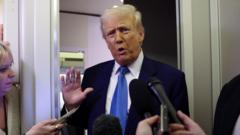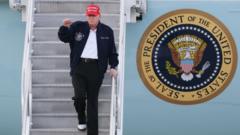The announcement which is set to take effect on March 4, 2023, raises concerns from both domestic industries reliant on the imported metals, as well as foreign suppliers like Canada, which previously accounted for a significant portion of U.S. aluminum imports. This latest development represents a significant escalation in the ongoing trade discussions, with Trump framing the tariffs as essential for revitalizing American manufacturing.
**Trump Implements New 25% Tariffs on Steel and Aluminum Imports**

**Trump Implements New 25% Tariffs on Steel and Aluminum Imports**
President Donald Trump has announced an expansion of import tariffs, imposing a 25% tax on all steel and aluminum entering the United States, a move that has ignited discussions around its potential economic impacts and international relations.
The imposition of tariffs has sparked immediate reactions from Canadian political leaders, prompting calls for retaliatory measures while raising questions about the stability of the U.S.-Canada trade relationship. The tariffs could also affect prices for consumers in the U.S., a concern expressed by business leaders across several industries reliant on steel and aluminum for manufacturing processes. Despite potential backlash from global trading partners and the U.S. manufacturing sector, Trump reassured that this step is ultimately aimed at bolstering domestic production of essential materials making clear that additional tariffs targeting pharmaceuticals and computer chips may also follow in time.
The announcement has mirrored similar trade policy measures from Trump's previous presidency, reflecting a pattern of using tariffs as a negotiation tool. Economic analysts express skepticism about the effectiveness of such tariffs to achieve job growth and address trade imbalances. Nevertheless, trade advocates supporting the tariffs echo Trump's narrative of protecting American jobs and fostering domestic production, particularly against a backdrop of competition from nations like China and Russia.
As the global market responds to these developments, the long-term implications of such policies on international trade dynamics will remain a focal point of scrutiny amongst economists and policymakers alike.
The announcement has mirrored similar trade policy measures from Trump's previous presidency, reflecting a pattern of using tariffs as a negotiation tool. Economic analysts express skepticism about the effectiveness of such tariffs to achieve job growth and address trade imbalances. Nevertheless, trade advocates supporting the tariffs echo Trump's narrative of protecting American jobs and fostering domestic production, particularly against a backdrop of competition from nations like China and Russia.
As the global market responds to these developments, the long-term implications of such policies on international trade dynamics will remain a focal point of scrutiny amongst economists and policymakers alike.






















